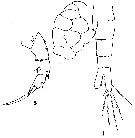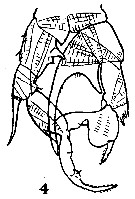|
|
 |
|
Calanoida ( Order ) |
|
|
|
Diaptomoidea ( Superfamily ) |
|
|
|
Pseudodiaptomidae ( Family ) |
|
|
|
Pseudodiaptomus ( Genus ) |
|
|
| |
Pseudodiaptomus forbesi (Poppe & Richard, 1890) (F,M) | |
| | | | | | | Syn.: | Schmackeria forbesi Poppe & Richard, 1890 (p.396, figs.F,M); Marsh, 1933 (p.44, figs.F,M); Shen & Tai, 1962 (p.101, Rem.). | | | | Ref.: | | | Burchardt, 1913, (p.380, fig.F, M: 11E, 12H, Rem. p.392: phylogeny); Sewell, 1948 (p.421); Shen & Lee, 1963 (p.577); Walter, 1986 (p.132); 1986 a (p.503); 1987 (p.367); Orsi & Walter, 1991 (p.553, figs.F,M) |  Issued from : C.D. Marsh in Proc. U.S. natn. Mus., 1933, 82 (18) (2959). [Pl. 21, figs.5, 7]. As Schmackeria forbesi. Female (from Yangtze Kiang): 5, P5; 7, urosome with egg sac (dorsal).
|
 Issued from : C.D. Marsh in Proc. U.S. natn. Mus., 1933, 82 (18) (2959). [Pl. 22, fig.4]. As Schmackeria forbesi. After Burckhardt, 1913. Male: 4, P5.
| | | | | Compl. Ref.: | | | Ohtsuka & al., 1995 (p.159); Cordell & al., 1997 (p.2, invasive species); Mauchline, 1998 (p.507); Choi & al., 2005 (p.710: Tab.III); Humphrey, 2008 (p.64, 84: Appendix A); Ohtsuka & al., 2008 (p.115, Table 6); Cordell & al., 2008 (p.753); Bollens & al., 2011 (p.1358, Table III, fig.8); DiBacco & al., 2012 (p.483, Table S1, ballast water transport); Bollens & al., 2012 (p.101, fig.2, Table 1, species competition); Kimmerer & al., 2014 (p.722, reproduction , growth vs food); Sabia & al., 2015 (p.460, Table 3, Rem.) | | | | NZ: | 3 | | |
|
Distribution map of Pseudodiaptomus forbesi by geographical zones
|
| | | | | |  Chart of 1996 Chart of 1996 | |
 Issued from : M. Winder, A.D. Jassby & R.M. Nally in Ecology Letters, 2011, 14. [p.753, Fig.3, d]. Issued from : M. Winder, A.D. Jassby & R.M. Nally in Ecology Letters, 2011, 14. [p.753, Fig.3, d].
Historical abundances of introduced species in the upper San Francisco Estuary between 1972 and 2009.
Adult stages are shown because immature stages were not continuously identified.
Pseudodiaptomus spp. is dominated by P. forbesi, whereas P. marinus contributed in small numbers. |
| | | | Loc: | | | China Seas (East China Sea, South China Sea, Yangtze-Kiang Riv.), Japan, California, San Francisco Estuary | | | | N: | 12 | | | | Lg.: | | | (1062) F: 1,20-1,35; M: 1,20; {F: 1,20-1,35; M: 1,20} | | | | Rem.: | Incomplete data.
In Lobus species group (forbesi subgroup) after Walter & al. 2006, p.203.
Form collected originally in fresh water near Shanghai, transported in ships ballasts to California (Sacramento Estuary).
According to Cordell & al., 2008 (p.753) the 1st record of this species in San Francisco estuary is 1987 and in Columbia River 2002.
ForBollens & al (2012) three non-indigenous species (of which P. forbesi) and two native planktonic copepods (Eurytemora affinis, Diacyclops thomasi) to co-occur and overlap to varying degrees in their distributions in the lower Columbia River estuary suggesting strong potential for competition. It is necessary to distinguish between the relative importance of biological ( competition and predation) and physico-chemical processes (freshwater runoff, eutrophisation) in regulating the dtnamics of native and non-indigenous copepods. | | | Last update : 02/09/2019 | |
|
|
 Any use of this site for a publication will be mentioned with the following reference : Any use of this site for a publication will be mentioned with the following reference :
Razouls C., Desreumaux N., Kouwenberg J. and de Bovée F., 2005-2024. - Biodiversity of Marine Planktonic Copepods (morphology, geographical distribution and biological data). Sorbonne University, CNRS. Available at http://copepodes.obs-banyuls.fr/en [Accessed April 20, 2024] © copyright 2005-2024 Sorbonne University, CNRS
|
|
 |
 |






